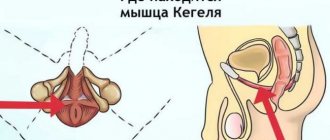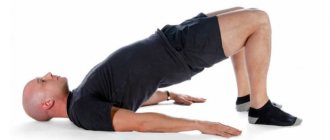Gymnastics for women using the Kegel method in its modern version has been known only since the 20th century, but long before that, representatives of the fairer sex trained the pelvic floor muscles with the help of exercises and various devices. One of the specific simulators used in ancient times was a stone egg with a strong thread. It was placed in the vagina, after which the muscles had to be held or pushed out and moved this round stone inside. Sometimes a weight was suspended from a strong thread to increase the effectiveness of the exercises.
We have heard mentions that women trained muscles in the small pelvis in Ancient Egypt, China, India and other countries. For the most part, hetaeras, priestesses and geishas paid attention to such gymnastics. The technique was hidden, used secretly, so only scanty data has survived to this day on how exactly the exercises were carried out.
Already in the 20th century, ancient traditions were resumed and became widely known as Kegel gymnastics for urinary incontinence in women. Doctors recommended resorting to this technique as an additional measure in the treatment of incontinence that occurs during exercise, coughing, sneezing and other situations when intra-abdominal pressure increases. Systematic implementation of medical recommendations helped strengthen the pelvic floor muscles, thereby eliminating involuntary urine leakage.
The first mention of the benefits of therapeutic exercises belongs to the US doctor Joshua Davis (1932), but the technique became most famous in 1948 thanks to the American scientist who introduced the exercise machine and gave his name to gymnastics. Since then, a set of Kegel exercises for women at home has gained mass popularity, and it is still relevant today.
The benefits of Kegel exercises for incontinence
The muscle fibers of the pelvic floor form a kind of hammock at the base of the pelvis. Their task is to fix and strengthen bone tissue, hold the bladder, urethra, intestines, uterus and maintain their functionality. The weakening of these muscles is associated with various reasons. This could be overweight, genetics, persistent constipation, menopause, excessive exercise and much more.
Whatever the reason for weak muscles, Kegel exercises for women are specially designed to strengthen them. The only condition is regularity and correct execution. You need to train until the pelvic muscles learn to reflexively contract in response to increased intra-abdominal pressure. This reflex will prevent involuntary leakage of urine.
So, it is advisable to do Kegel exercises for urinary incontinence in women if:
- urine is released when coughing or sneezing, laughing and physical activity, as well as during intimate relationships;
- when playing sports you have to wear urological pads;
- muscles weakened after pregnancy and childbirth;
- I am unable to hold urine when there is an urgent urge.
In these situations, Kegel exercises will help strengthen the muscles of the genitourinary organs, and the problem will be solved quickly and effectively.
Kegel exercises for urinary incontinence in women
Kegel gymnastics is a specially designed set of exercises that combines special contractions and relaxations, compression of the pelvic muscles.
They are performed in different body positions and at different frequencies and tempos.
Who are the exercises for?
A set of exercises according to the Kegel program will be useful:
- girls who are planning pregnancy in the near future;
- pregnant women, of course, in the absence of contraindications, which will be discussed below;
- women after the birth of a baby, when the muscles and tissues of the pelvis are stretched, and exercises will help restore them to tone;
- after 30 years, when the risk of developing prolapse of organs and systems of the pelvic cavity increases significantly;
- in case of prolapse or abnormal location of the pelvic organs, a set of Kegel exercises will help restore tone and, accordingly, their anatomically correct position;
- for urinary/fecal incontinence - exercises according to the program developed by Professor Kegel will help solve this problem;
- when diagnosing congestion in the pelvic organs and systems;
- with decreased libido in men and women, sensuality during sexual intercourse.
Contraindications
Despite all the benefits of this set of trainings, they also have their contraindications. These restrictions are:
- the course of acute and chronic diseases provoked by the inflammatory process in the acute stage;
- diagnosing erosive lesions of the cavity and cervix and oncology;
- internal bleeding and local inflammatory diseases;
- diseases and pathological abnormalities in the structure and functioning of the cardiovascular system, as well as recently undergone surgery;
- during the period of gestation with increased uterine tone in a woman and suspected premature birth or miscarriage.
Benefits of gymnastics
When regularly performing Kegel exercises, the following undeniable benefits for women arise:
- restoration of genitourinary control;
- getting rid of uterine prolapse and displacement of the bladder in the pelvic area;
- excellent help and prevention regarding incontinence;
- improvement and strengthening of sexual desire and orgiastic impressions, duration of sexual intercourse.
Preparation for execution
Before you start doing gymnastics according to the developed Kegel program, you should visit the toilet and empty your bladder. To get a positive result, you should start practicing gradually, increasing the number of exercises more than once.
How to identify the pelvic floor muscles?
To determine the muscle tissues of the small pelvis that need to be trained, just lie on your back and insert a finger into the vagina, closer to the side wall.
Next, you should contract your muscles, as during a volitional cessation of urination, and feel the tension. These muscles are worth training.
There is a simpler way - while visiting the toilet and urinating, use your willpower to try to stop this process. Remember the sensations themselves and reproduce them during training using Kegel exercises.
How to do the exercises correctly?
Before you start exercising, visit the toilet and empty your bladder. Next, you should take a body position that is comfortable for you - lying on your back or sitting and perform them in this position.
The most common exercises are the following:
Hold
To perform it, you should lie on your back and take the following body position - arms along the body, legs bent at the knee joint and spread to the side.
Tighten and relax the muscle fibers in the perineal area - at the peak of tension, hold the muscles for 5-6 seconds, relax. Start doing this exercise with 10 repetitions, gradually increasing to 30.
Reduction
This exercise involves contracting and relaxing muscle tissue located in the perineal area as quickly as possible. It is performed without restrictions, many times a day from a supine position, placing a pillow or bolster under the buttocks.
At the very beginning of performing this Kegel exercise, you should squeeze the vaginal muscles and, with an effort of will, hold them in this position for 5-6 seconds, gradually increasing the compression force.
Having reached the maximum point of tension, proceed in the reverse order, relaxing the muscle fibers without sudden movements. Repeat this at least 8-10 times.
Waves
The essence of this exercise is wave-like tension and subsequent relaxation of the pelvic muscles in a certain order. First, they tense the muscles of the vagina, then the anus, and so form a semblance of a wave - relax them in the reverse order.
Positioning
The presented exercise is best performed by pregnant women - first of all, you should empty your bladder and intestines, then relax and hold your breath while inhaling. Afterwards, push and relax.
Protrusion of the pelvic floor forward
Take a position as during childbirth, and relax the internal pelvic muscles as much as possible through willpower. Next, hold your breath and, as it were, push, protruding the vaginal muscles outward.
Flashing
This exercise allows you to train the muscles of the vagina and anus, reminiscent of the Wave exercise. But in this case, the muscle tissue of the vagina is contracted first, and then the anus, observing the principle of inhaling - holding, relaxing while exhaling.
How to check if it's done correctly?
If you perform all the exercises correctly, a positive result will be noticeable after 1-1.5 months, but if the muscles of the pelvic organs are too weak, this period can increase to 3 months.
Errors in performing gymnastics
If performed incorrectly, you can achieve the opposite effect when the pelvic muscles relax excessively. Experts consider such mistakes in the process of performing exercises to be excessive protrusion of the navel and holding your breath for too long.
A sharp relaxation of the muscles of the pelvic organs is also unacceptable - this will provoke a break and their abnormal protrusion outward. That's right - maintain rhythmic and deep breathing, pull the pelvic muscles upward.
What results should you expect?
As statistics show, the positive results are:
- Reduction and complete cessation of drip-type incontinence of urine and feces.
- Gymnastics also has a positive effect on the sexual side of relationships - it increases potency and enhances libido, elasticity and muscle control.
- Gymnastics itself serves as an excellent preventive measure against many bladder diseases.
- You can also train during pregnancy, taking into account existing contraindications. They are also indicated in the postpartum period, allowing the woman’s genitourinary system to be restored in a short period of time.
Kegel exercises for pregnant and postpartum women
Pregnancy and childbirth are a difficult process for the body, during which the condition of the muscles in the pelvis plays a big role. Weak tone of other muscles of the body, although it can cause discomfort, is not so dangerous. Weakened pelvic muscles are fraught with painful, protracted labor, as well as decreased libido, prolapse and prolapse of the uterus, and urinary incontinence. Often women experience urine leakage, both during pregnancy (the fetus puts pressure on the bladder) and after childbirth. The second option awaits those who have poor muscle function. Therefore, doctors recommend training them in advance, monitoring their condition during pregnancy and maintaining muscle tone after childbirth.
While carrying a child, thanks to Kegel exercises for urinary incontinence, a woman's tissue elasticity increases, venous congestion decreases, joint mobility improves, intestinal function improves, and the risk of involuntary urine loss decreases. Kegel exercises to strengthen muscles are also important for the birth process itself, since their condition directly affects the maintenance of pregnancy and recovery in the postpartum period.
It is convenient that the training can be carried out at home - Kegel exercises for women do not require a special room and exercise machine and can be performed at any time. You need to exercise before and after childbirth, since muscle elasticity is always needed. Before the baby is born, this will help him to be born, and after that it will speed up the healing of ruptures and prevent organ prolapse. Even after a cesarean section, exercise is beneficial because muscle tone in pregnant women is reduced due to gravity.
Kegel exercises for urinary incontinence
Uncontrolled urination causes discomfort and deteriorates a person's standard of living. You can strengthen the genitourinary system through regular exercises; Kegel exercises for urinary incontinence are suitable for women.
Urinary incontinence: causes
Incontinence is a frequently diagnosed complaint among patients. According to statistics, more than 30% of the adult population of Russia encounter it. Urinary incontinence is not an independent disease, but a symptom of a pathological process occurring in the human body. In 20% of cases in women it becomes chronic. According to the degree of progression, the pathology is divided into:
- primary – more often occurs against the background of transient incontinence, is temporary in nature, subject to proper treatment. Often caused by hypothermia of the pelvic organs;
- chronic – the pathology is long-lasting and can be cured only in the case of combined treatment of the provoking disease.
When a symptom is constantly present or returns periodically, it is worth thinking about the reasons. These include:
- age is the most common provocateur of disease. With age, metabolism in older people deteriorates, and muscles and sphincters weaken;
- prostate surgery – if the operation goes without complications, the symptom is temporary, but must be monitored by a specialist;
- neurological diseases - disruption of neural connections between the genitourinary system and the brain;
- dysfunction - improper functioning of the muscles and sphincters of the genitourinary canal.
Other factors that provoke enuresis:
- age-related changes;
- recent stroke;
- oncological disease of the genitourinary system;
- prostate TURP surgery;
- removal of adenoma;
- alcohol intoxication;
- laughter, coughing, sneezing;
- removal of the urinary catheter;
- multiple sclerosis.
LUTS are symptoms of the lower genital tract and are quite common in urologist practice. They are divided into three groups: a sign of accumulation, a sign of emptying, a sign after emptying. Signs include: frequent or infrequent urination, pain during or after emptying the bladder, sensations of an incompletely emptied bladder.
The cause of pathology can be many diseases and situations. To accurately diagnose the symptom, it is better to consult a specialist. Pelvic exercises help reduce or get rid of the symptoms of urinary incontinence.
Types of incontinence
Further treatment depends on determining the nature of the disease.
- Urgent or imperative incontinence is associated with the inability to hold urine at the peak of the urge to urinate. It is often a consequence of pathologies of the brain or spinal cord, hormonal imbalances, infectious diseases, or damage to the bladder.
- Stressful – this type is associated with the inability to hold urination during pressure on the abdominal area. May be caused by straining, coughing, sneezing or laughing. It is a consequence of improper functioning of the sphincters of the urinary canal, nerve conduction in the bladder area or hormonal disorders.
- Mixed. With this type of incontinence, mixed causes of urge and stress incontinence are observed.
- Paradoxical - urinary incontinence when the bladder is full. More common in older patients. Associated with diseases of the genitourinary organs.
- Transient – short-term incontinence. Develops due to cystitis, surgery, alcohol or drug intoxication, constipation.
Kegel exercises for urinary incontinence
Despite the fact that many people experience incontinence, not everyone considers this problem serious and does not consider it necessary to consult a doctor. Spontaneous leakage of urine leads to a deterioration in quality of life and social connections. Also, pathology affects all spheres of human life: spiritual, emotional, everyday.
The muscle of the same name is located in the pelvic floor, with its help the stream stops during urination. Remember which muscle tenses when the jet stops and do exercises throughout the day. The workouts look like this: tense the muscle for a few seconds, then relax. Classes can be carried out during any other activities. It is recommended to repeat the cycle of tension and relaxation 30-40 times a day.
Regular exercises guarantee good results. Strengthening the Kegel muscle not only relieves urinary incontinence, but also prevents the risk of developing prostatitis, hemorrhoids, and prostate adenoma. Also, a toned muscle increases libido.
Basic Kegel exercises to strengthen the genitourinary system
There are several types of exercises - classic and advanced.
The classic Kegel exercise involves alternately tensing and relaxing a muscle for a few seconds. The exercise is simple and can be done anywhere - in line, at the workplace or before bed. It will not be noticeable to others that you are exercising, but in the meantime you are strengthening your bladder muscles.
Advanced exercises come from 70 years of exercise practice.
Frequent contractions
Perform the classic exercise at speed. The ideal result would be 60 contractions per minute. By training daily, this result is easy to achieve.
On inspiration
Muscles consume a lot of oxygen, so many muscle tension exercises are done while inhaling. Place your feet shoulder-width apart, slowly inhale air through your nose, also slowly and gradually tensing the muscle.
On the exhale
During muscle training, try to relax it as much as possible. The correct way to do this is while exhaling while lying on the bed before going to bed. Take a comfortable position on your back.
Blockade
Squeeze the muscle as tightly as you can. Stay in this position for 5-10 seconds. Add 5 seconds a day to the exercise and soon you will achieve excellent results.
Up down
When performing this exercise, visualizing the takeoff and landing of the plane is a great help (for a complete picture, watch the takeoff video). Imagine how your body rises higher, along with the Kegel muscle. Pause at the peak and begin to decline. Breathe evenly and without interruption.
Bridge
This familiar exercise from physical education lessons perfectly strengthens the muscular corset and small pelvis. If it’s difficult to do this out of habit, start by raising your pelvis. To do this, lie on the floor, bend your knees and alternately raise and lower your pelvis. The exercise should be done intensely.
Exercises with simulators
In addition to regular exercises, many women use assistive accessories. Vaginal balls tone the vaginal muscles due to the woman’s constant control over their position. This technique helps to train the muscle faster, since the exercises are performed with weights. Vaginal balls come in different sizes, textures and shapes - finding the most convenient option is not difficult.
Conclusion
The pathology of incontinence is a serious symptom; under no circumstances should you be negligent about even one-time manifestations. Uncontrolled urination can seriously impair your quality of life. It is necessary to undergo an examination by a urologist once a year; if the problem is stopped at an early stage, regular physical exercises can help. The Kegel technique has proven itself and has helped many people get rid of the symptoms of urinary incontinence. Doctors recommend: if you experience symptoms of incontinence, be sure to consult a specialist.
Sources: https://1opochkah.ru/lechenie/gimnastika-kegelja-pri-nederzhanii-mochi.html https://appetitelove.ru/uprazhneniya/pri-nederzhanii-mochi https://urohelp.guru/mochevoj-puzyr/ urostoma.html
Additional benefits of intimate muscle training
In addition to the benefits of Kegel exercises for urinary incontinence in women, they are beneficial for the health of various systems and the body as a whole. In particular, we are talking about sexual health. If a representative of the fairer sex notices weakened tone of the vaginal muscles (or her partner notices this), wants to improve the quality of sensations received during intimacy, or increase libido, you need to start training immediately. Thanks to regular training, the tone of the pelvic muscles will increase and blood circulation in this area will improve (which is important for those whose activities involve being in a static position for a long time). A woman will be able to control her intimate muscles, which will expand the range of sexual sensations, give joy from intimate caresses and increase libido.
Kegel exercises will also bring significant benefits to those entering the menopause phase. During this period, sexual intercourse can cause discomfort and pain, and the external genitalia are not sufficiently moisturized. If we add to this the increased likelihood of ureteral infections, the picture is bleak. The sooner you start gymnastics, the faster you can eliminate problems. Thanks to regular training, blood circulation will improve, and with it the condition of the mucous membranes. The risk of skin damage during sexual intercourse will decrease, which means the likelihood of infection will decrease. At the same time, the muscular tissue of the genitourinary system will be strengthened, which will prevent incontinence.
How to do the exercises correctly
To properly perform Kegel exercises for urinary incontinence in a woman, you first need to determine which muscles should be used. Detecting them is not difficult, and there are several simple ways to do this:
- While urinating, pause the stream, then relax and continue. Remember the muscle that had to be tensed when the process was stopped.
- Imagine that you need to keep gases inside the intestines when they try to come out. To do this, tense your muscles as much as possible and remember the feeling.
- Wash your hands, lie down on the sofa and insert a finger into the vaginal cavity, and then try to grasp it with your internal muscles. If you manage to tighten them so that your finger feels a gentle squeeze, this is what you need.
Any of the listed methods or a combination of them can be used for beginners to find the very muscles that need to be strengthened. In the future, a course of gymnastics consists of sequential contraction and relaxation of this muscle. Regularity and patience are important, and soon the result will be noticeable.
Kegel exercises can be done anywhere and at any time - at home, in transport, at your desk, in line. People around you will not guess that the woman is doing the exercises. It is advisable to take a comfortable position - standing, sitting or lying down, and then concentrate on specific muscles. Next, you need to sequentially compress and relax the muscles, while counting to three for each movement. It doesn't matter whether you're watching TV, driving, reading a book or taking a bath - exercise, and the more often the better. Doctors' recommendations boil down to the fact that it is advisable to perform the exercise three times a day, each time in a new position, and increase the number of repetitions to 10–15. With this schedule, a significant effect will appear in 2-3 months.
You need to understand that for urinary incontinence in women, Kegel gymnastics is not the only method of treatment, but part of complex therapy. Execution technique and regularity are of great importance. It is advisable to consult a doctor.
Urinary incontinence: medications, physical therapy, training, surgery
Author:
Reznik Irina
4 minutes
2490
Often after childbirth, a woman faces the problem of urinary incontinence. According to statistics, one fifth of all women aged 35–45 years suffer from this to one degree or another. There are more of them with age. Most often, urinary incontinence occurs due to pelvic organ prolapse, which is explained by weak connective tissue. Excess weight, chronic diseases accompanied by coughing and sneezing are also among the culprits of the problem. Marina Nakryzhskaya, head of the Center for Pelvic Floor Surgery, head of the gynecological department of City Clinical Hospital No. 17, Moscow, spoke about whether there is a solution to this problem.
Marina Nakryzhskaya
A delicate problem
Many women are embarrassed to talk about this delicate issue. Coughing, sneezing, sex, any – even the most insignificant – physical activity lead to the fact that the bladder “does not listen.” Doctors call this problem stress urinary incontinence (or stress urinary incontinence). A characteristic feature of stress urinary incontinence is the absence of the urge to urinate.
Fearing being in an awkward position, a woman becomes a recluse. Sports, travel, and visiting are now prohibited. Ladies are forced to avoid sex. The woman develops an inferiority complex and depression. If at first the problem was solved by “daily” pads, then you have to switch to “night” pads, used on critical days, and finally buy special urological pads at the pharmacy.
7 ways to solve the problem without surgery
Treatment begins with conservative methods.
1. The simplest thing is training to strengthen the pelvic floor muscles .
For this purpose, there is a special Kegel gymnastics complex, named after its author. Here is one training option. Imagine that your vagina is an elevator car going up to the 5th floor. Squeeze the muscles smoothly, starting from the “ground floor” - the entrance to the vagina. Having risen to the “second floor”, hold the contraction for a few seconds. Then climb to the “third floor”. Again – pause... When you find yourself at the very top of the cervix, go down in the “elevator” in the same way, making stops at each “floor”.
At first glance, it looks simple. But, in fact, when doing these exercises, you must follow the rule - the abdominal and buttock muscles should rest when performing gymnastics, and only the vaginal muscles work. You are training your intimate muscles, not your abdominal muscles. To check whether the first ones are not slacking, place one palm on your stomach and the second palm under your buttock. The hands should not feel movement, otherwise gymnastics is useless and even harmful - it aggravates age-related organ prolapse and hemorrhoids.
2. The biofeedback apparatus , which will act as a kind of trainer, will help you avoid mistakes when performing gymnastics.
One electrode from this device is attached to the vagina, the others are placed on muscles that cannot be strained. The woman, looking at the monitor, begins to perform Kegel exercises correctly and very quickly achieves optimal functioning of the vaginal muscles. You can clearly see on the screen how they work, and it is easy to ensure that the abdominal and buttock muscles do not interfere with the exercises.
3. Another training option is using so-called vaginal cones (a kind of weights of different weights).
They are sold in pharmacies, and you can order them online. First, place the lightest cones into the vagina for a few minutes a day. Once you get used to the load, you can move on to the next weight. Thanks to such “strength” exercises, the desired group of pelvic floor muscles is “pumped”, and it is now easier to control the process of urination.
4. Microcurrents and electromagnetic pulses from the arsenal of physiotherapy will help strengthen muscles and make tissue more elastic by improving blood supply to the pelvis.
After exposure to magnetic wave currents, the tissues regain lost strength and elasticity, they “remember youth” and begin to work as expected again - only at the request of the owner, and not when sneezing, laughing or coughing. Several courses will be required. But physiotherapy helps only at the initial stage of the problem.
5. The simplest option is the use of local hormone replacement therapy.
Suppositories or cream with estrogen are inserted into the vagina according to a certain scheme - first daily for a certain period of time, then reducing the dose to once a week. But recently, scientific research has appeared that proves that HRT has many more side effects than benefits.
6. Some people use medications that reduce the frequency of episodes of urinary incontinence.
Sometimes urinary incontinence is associated with depression, so antidepressants can help in such situations. Having escaped from the psychological problem, the woman forgets about incontinence. But here we must remember that self-prescription of some drugs (for example, m-anticholinergics) is dangerous, since the drugs cause many side effects. For example, they can provoke retinal detachment and cause blindness.
7. Injections of hyaluronic acid into the tissue closest to the urethra. But the effect of such injections is not always sufficient, and also short-lived. Injections must be done regularly, which is not cheap.
If all the previous methods did not help or you abandoned them for your own reasons, there is only one way out - surgery.
The weakened urethra will be supported by the installation of a free synthetic loop. During the operation, a sling made of synthetic bioinert material is implanted. To install this tape, an incision about 1 centimeter long is made on the anterior vaginal wall. And also 2 punctures with a diameter of less than 5 millimeters - on the skin in the area above the pubis or in the inguinal folds. A thin ribbon is inserted under the urethra, its ends are pulled out, a small loop is obtained, which, like a hammock, supports the urethra in normal condition. After some time, the sling grows its own connective tissue. It becomes part of the body itself and supports the urethra during any sudden increase in intra-abdominal pressure that the body experiences when coughing, sneezing, or physical activity.
Today, the surgical technique has been refined to the smallest detail. It has no age restrictions. It is performed under spinal or intravenous anesthesia for 10 minutes. If there are no complications, the woman is discharged the next day after surgery. Recovery occurs very quickly. The loops are soft, usually patients do not feel them, but occasionally, immediately after surgery, a woman feels a foreign body. This feeling passes quickly. Within a month after installing the sling, the woman returns to her normal full-fledged lifestyle without restrictions.
If the problems are more serious - prolapse of the internal genital organs or even prolapse - modern medicine is also ready to cope with them. At the initial stage of prolapse, special synthetic threads with notches are installed, which create a “lifting effect”. And in case of prolapse, special mesh prosthetic implants will be needed; they will strengthen the organs’ own tissues.
It is important that women of any age, at the first manifestations of incontinence, do not endure discomfort, do not fight complexes, but seek help from specialists.
The right approach
Experts give the following recommendations on how to properly perform Kegel exercises for women:
- empty your bladder immediately before class;
- choose a comfortable position - sitting, lying or standing. If the preferred position is lying on your back, your arms should be extended along the body and your knees slightly raised. The neck should not be strained;
- The main movement in any Kegel exercise for women is compression (contraction). It is important to avoid tension in the abdominal muscles, buttocks and thighs, otherwise there will be no result;
- you need to breathe deeply, evenly and calmly, without delay;
- you cannot contract the intimate muscles when urinating - this method, on the contrary, weakens the pelvic floor muscles;
- repeat the complex 3-4 times during the day, performing 5 to 40 repetitions each time. You cannot sharply increase the load, only gradually: perform 15 repetitions for 2 weeks, 20 repetitions for the next 2 weeks, etc.
The correct technique for performing Kegel gymnastics for women allows you to feel the first positive results after just six weeks of regular exercise. Changes will be noticeable in all areas of life, including intimate ones, and self-confidence will even increase.
Precautionary measures
Considering the specifics of their implementation, Kegel exercises for women have almost no contraindications. The exception is a recent miscarriage, premature birth and major surgery, or the presence of malignant neoplasms. In these cases, you should not overexert yourself. But in any case, you should always consult your doctor before starting classes. Even if there are no contraindications, but you feel discomfort or pain during exercise, you should stop and consult a doctor. You can resume training only with the permission of a doctor. A consultation with a gynecologist will be needed if after 3-5 months of regular training there is no change for the better. The rest of the exercises are flawless - there are no strength loads or cardio stress, no need to spend money on exercise machines, equipment, or a trip to the gym. The minimum investment of effort and time will pay off with improved well-being in all areas.
Basic elements of gymnastics
A wide selection of Kegel exercises for women allows you to actively work out the pelvic muscles and those located next to them. A set of 10 most effective:
Compression
Take a comfortable position. Contract your intimate muscles, hold for 10 seconds, relax. Repeat 10–12 times, eventually increasing the number to 50.
Reduction
Contract and relax the desired muscles for 5 seconds, choosing a comfortable pace. Rest 5 seconds and repeat. The number of repetitions for beginners is 10 times. Over time, increase both the number of approaches and the duration of the contraction cycle.
Pulsation
Reminiscent of the previous Kegel exercise for women, but requires you to contract the muscles as quickly as possible for 5 seconds.
Elevator
Take a comfortable body position and imagine that the vaginal muscles are an elevator shaft.
By contracting the muscles, move the imaginary elevator car up, then lower it down, relaxing the muscles on each “floor.” After a short break, repeat. Flashing
Engage the muscles of the vagina and anus.
Alternately contract and relax the muscles at a comfortable pace for 5 seconds, imitating a wave-like movement. In the future, increase the duration of the lesson to 20 seconds. Expulsion
Empty the bowels.
Take a comfortable position, relax your body and start pushing. The exercise is useful for expectant mothers. Hold
While inhaling, squeeze the desired muscles as hard as possible.
Hold for 6 seconds, while exhaling, gradually relax. Repeat 5-6 times. Relaxation
Reminiscent of the previous exercise, but as you exhale you need to sharply relax the muscles, as if pushing out the air.
Half bridge
Lie on your back.
Place your feet on the floor, bend your knees. Shoulders and feet do not leave the floor. Raise your pelvis high (there is no need to specially strain your intimate muscles, they will start working on their own), stay at the top point for 10 seconds, and return to the starting position. Repeat 10–20 times. This exercise to strengthen the pelvic muscles will improve blood circulation in this area and saturate the tissues with oxygen. Samba
Stand up straight, place your palms on your hips and place your feet shoulder-width apart.
Move your hips to the sides, slightly bending your knees. At the extreme points on the left and right, strongly squeeze the intimate muscles and relax them as you move towards the center. Repeat 25 times. The listed Kegel exercises for women are enough for a full workout of the intimate muscles. It is advisable to practice for a long time, ideally throughout your life.
A set of exercises for training the pelvic floor muscles
For older people, there are three simple exercises for training the muscles of the urethrogenital diaphragm, aimed at solving the problem of involuntary urination. They must be performed constantly and regularly, each for at least one minute.
Exercise "chair"
From a standing position, with your hands shoulder-width apart, you need to sit down as if you were sitting on a chair. In this case, you cannot lean forward. The back should be straight. Bend your knees to a 900 angle or as much as possible with a straight back and stay in that position. If at the initial stage it is difficult to hold this position for a minute, then you can limit yourself to thirty seconds, gradually increasing the time of the exercise.
Exercise "butterfly"
While lying down, bend your knees and then spread them so that your knees point towards the floor and your feet touch each other. Also stay in this position for about one minute and feel the stretch in your muscles. During this exercise, your knees should point down.
Exercise "child's pose"
Get on all fours. Sink down onto your heels. Stretch your arms up and from this position lean forward so that your forehead and palms touch the floor. Hold this position again, feeling the stretch in those same pelvic floor muscles.
Features of classes for women over 50
Women who have celebrated their anniversary should not consider themselves pensioners and give up intimate life. With age, the muscles of the vagina lose their tone, and the pressure of the uterus on the bladder often provokes incontinence. If you supplement the sensations with manifestations of menopause, the picture is not rosy. There is a solution to the problem: thanks to Kegel gymnastics for women, you can restore muscle tone at any age, eliminate discomfort, and prevent diseases of the pelvic organs. It will take longer to practice until you get the desired result than in your youth, but the effect will be there.
Types of incontinence, their features
Doctors call urinary incontinence incontinence and divide it into three types:
- Stress incontinence. Possible only in the presence of increased intra-abdominal pressure caused by lifting weights, playing sports, sexual intercourse, sneezing, laughing or coughing.
- Urgent urinary incontinence. It suggests an unbearable urge to urinate, such that a woman may sometimes not have time to run to the toilet. But the bladder may be half empty.
- Mixed form of incontinence. Here the symptoms of the first two forms of incontinence are combined.
Any type of incontinence is always a great stress and worry for a woman and the cause of many pathologies.
Is it possible to exercise during menstruation?
If you regularly do Kegel exercises for women, menstruation will be less painful. Many girls and women around the world experience severe pain, from which they save themselves with pills. But you don’t have to take strong medications every month. You can try to perform simple exercises to strengthen intimate areas and reduce the discomfort that occurs on “critical” days, if it is not associated with the presence of pathology.
During menstruation, Kegel gymnastics does not pose a threat to women, you just need to avoid overloading the body. You cannot immediately go for a record - the number of repetitions and the time of muscle contraction are increased gradually.
Charging should be postponed in case of infectious diseases of the genitourinary system. Only after consulting a doctor and making a diagnosis, having completed the prescribed treatment, can you resume gymnastics as soon as your health returns to normal.
Also watch our video tutorial:











